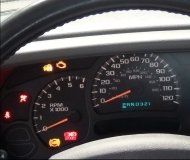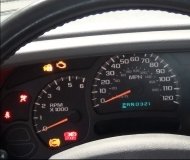I have a feeling it's related to it or the coil. Here are directions for testing. Let me know what you find or if you have other questions.
The first directions are for the ICM. The attached pics are the flow charts.
______________________________________
1991 Chevy Truck K 2500 Truck 4WD V8-454 7.4L
Ignition System Check
Vehicle Powertrain Management Relays and Modules - Powertrain Management Relays and Modules - Computers and Control Systems Engine Control Module Testing and Inspection Component Tests and General Diagnostics Electronic Control Module (ECM) Tests - TBI Ignition System Check
IGNITION SYSTEM CHECK
Ignition System Check (Remote Coil/Sealed Module Conn. Dist.)
pic 1
Wiring Diagram For Ignition System (Remote Coil/Sealed Module Conn. Dist.)
pic 2
IGNITION SYS. CHECK (SEALED MODULE CONN. DIST.)
TEST DESCRIPTION: Numbers below refer to circled numbers on the diagnostic chart.
1. Two wires are checked, to ensure that an open is not present in a spark plug wire.
1A. If spark occurs with EST connector disconnected, pick-up coil output is too low for EST operation.
2. A spark indicates the problem must be the distributor cap or rotor.
3. Normally, there should be battery voltage at the "C", and "+" terminals. Low voltage would indicate an open or a high resistance circuit from the distributor to the coil or ignition switch. If "C" terminal voltage was low, but "+" terminal voltage is 10 volts or more, circuit from "C" terminal to ignition coil or ignition coil primary winding is open.
4. Checks for a shorted module or grounded circuit from the ignition coil to the module. The distributor module should be turned "OFF, " so normal voltage should be about 12 volts. If the module is turned "ON, " the voltage would be low, but above 1 volt. This could cause the ignition coil to fail from excessive heat. With an open ignition coil primary winding, a small amount of voltage will leak through the module from the "Bat." To the "tach" terminal.
5. Applying a voltage (1.5 to 8 volts) to module terminal "P" should turn the module "ON" and the "tach" terminal voltage should drop to about 7-9 volts. This test will determine whether the module or coil is faulty or if the pick-up coil is not generating the proper signal to turn the module "ON." This test can be performed by using a DC battery with a rating of 1.5 to 8 volts. The use of the test light is mainly to allow the "P" terminal to be probed more easily. Some digital multi-meters can also be used to trigger the module by selecting ohms, usually the diode position. In this position the meter may have a voltage across it's terminals which can be used to trigger the module. The voltage in the ohm's position can be checked by using a second meter or by checking the manufacturer's specification of the tool being used.
6. This should turn "OFF" the module and cause a spark. If no spark occurs, the fault is most likely in the ignition coil because most module problems would have been found before this point in the procedure. A module tester could determine which is at fault.
______________________________________
Coil testing.
1991 Chevy Truck K 2500 Truck 4WD V8-454 7.4L
Ignition Coil Test
Vehicle Powertrain Management Ignition System Ignition Coil Testing and Inspection Component Tests and General Diagnostics Ignition Coil Test
IGNITION COIL TEST
Ignition Coil Testing
pic 3
PROCEDURE:
1. Disconnect the distributor lead and wiring from the coil.
2. Connect an ohmmeter as shown in step 1 of the image above. Use the high scale. The reading should be infinite. If not replace coil.
3. Connect an ohmmeter as shown in step 2 of the image above. Use the low scale. The reading should be very low or zero. If not, replace coil.
4. Connect an ohmmeter as shown in step 3 of the image above. Use the high scale. The meter should NOT read infinite. If it does, replace the coil.
5. Reconnect the distributor lead and wiring to the coil.
__________________
Let me know.
Joe
Images (Click to make bigger)
Thursday, February 18th, 2021 AT 1:01 PM
(Merged)









